 It’s December once more, which means it’s a great time to learn a whole bunch of strange, interesting, and funny things so you have a quiverful of “well actually’s” to spring on bewildered family members over holiday dinners. Come join us for boozy lectures, DJ Alpha Bravo, a full bar, and delicious eats. Be there and be square!
It’s December once more, which means it’s a great time to learn a whole bunch of strange, interesting, and funny things so you have a quiverful of “well actually’s” to spring on bewildered family members over holiday dinners. Come join us for boozy lectures, DJ Alpha Bravo, a full bar, and delicious eats. Be there and be square!
Wednesday, 12/18/2019
Doors at 7pm, show at 8
Rickshaw Stop, 155 Fell St @Van Ness
$10, all ages
Tickets here———————————
“Scripting Outside the Lines” with Michael Epstein
How do you write a script for a story where the audience’s reactions — and their surroundings — will end up driving the plot and character development? That’s an incredible challenge in the age of AR/VR/XR, interactive Netflix shows, escape rooms, and participant theater. These are all “immersive media” where you are, if not the star, at least a castmember. And it requires a totally different way of storytelling.
Michael Epstein is an immersive media producer at Walking Cinema and Professor of interactive storytelling at California College of the Arts. We’ll look at various ways immersive scripts are being written and talk about Michael’s own writing process that incorporates urban landscapes, hidden artifacts, serendipity and community participation.
———————————
“Shark Electrosensors – A Sixth Sense” with Brandon Brown
As we stub our toes in the dark, or spin around helplessly trying to figure out which way is “North” when our phones can’t connect to a network, it sometimes feels like we could do with an extra sense or two. And some animals have them – in the murky depths, sharks and their relatives are able to detect electricity and use it to navigate their world. We’ll explore the physics, chemistry, and biology behind these “electrosensors” and “see” what a shark’s “electric vision” might be like.
Brandon is a Professor of Physics at the University of San Francisco whose lab focuses on electric and magnetic sensory abilities of animals. He’s also an author, and his most recent book is “The Apollo Chronicles: Engineering America’s First Moon Missions“.
“Feeding the Future: An Insect Approach to Sustaining Humans and Habitats” with Brian Fisher
Journey from San Francisco to Madagascar with Brian Fisher, PhD, an entomologist at the California Academy of Sciences. As the climate crisis unfolds and biodiversity vanishes in what is now considered the sixth mass extinction, Fisher is on the front lines tracking big-scale changes—all with the help of insects. By closely monitoring invertebrate populations, which rapidly respond to changes in their environment, Fisher is developing a system to flag early signs of ecosystem collapse. There’s no better place to put this monitoring tool to the test than off the coast of East Africa on the island nation of Madagascar. Here, the Malagasy people face a malnutrition crisis: Tropical forests are disappearing at unprecedented rates to make way for pastures and cropland. Fisher searched for a win-win alternative until he found a solution that chirped. In 2017, he and his collaborators launched Valala Farms, a Malagasy organization that produces protein-packed cricket powder to fight food insecurity and alleviate pressure on endangered species habitat. Today, Valala Farms delivers both meal supplements and insect-farming methods—which are easily replicated—to villages in need across the country. Join us for a fascinating discussion about the global biodiversity crisis, the need for breakfast before conservation, and how often-forgotten insects are fueling the future.
———————————
With: Alpha Bravo, who’ll be spinning tunes specially selected to match the presenters’ themes. Follow the set list on Twitter @djalphabravo.
Food: The very delicious Venezuelan fare of Miss Arepita.
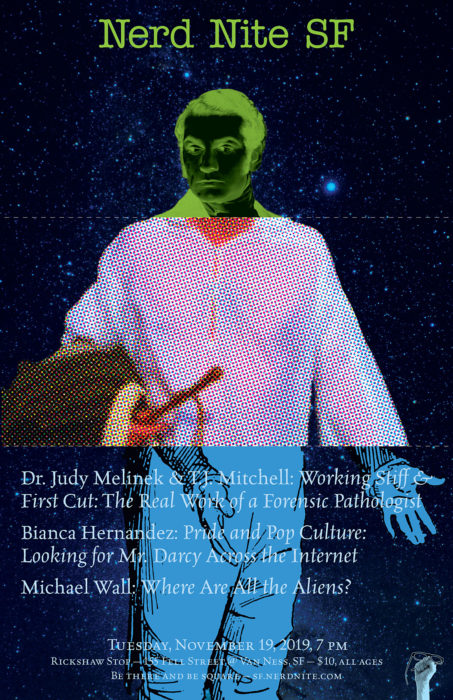 What’s this? A TUESDAY?! November scheduling shuffles have temporarily moved us to a new night, but we’ll still have the same fantastic show.
What’s this? A TUESDAY?! November scheduling shuffles have temporarily moved us to a new night, but we’ll still have the same fantastic show.
Brace yourselves, for there will be much swooning and we are rather short on fainting couches! There will be talks on autopsies, shirtless Mr. Darcys, and little green men. To steel your nerves, there will music by DJ Alpha Bravo, a full bar, and delicious eats. Be there and be square!
Tuesday, 11/19/2019
Doors at 7pm, show at 8
Rickshaw Stop, 155 Fell St @Van Ness
$10, all ages
Tickets here
———————————
“Working Stiff & First Cut: The Real Work of a Forensic Pathologist” by Dr. Judy Melinek and T.J. Mitchell
Dr. Judy Melinek performs autopsies for a living. Her husband, T.J. Mitchell, is a writer. Together they will answer everything you dare ask a medical examiner, give you a tour of the morgue, take you through a scene investigation and autopsy, and explore the science of gunshot wounds in a real-life, true-death case study. Drink up and gird yourselves for graphic photos!
Judy and T.J. are the authors of Working Stiff, about forensic pathology in the real world, not that CSI nonsense. Their new novel, First Cut, is available for pre-order at drworkingstiff.com. They will also have signed and dedicated paperbacks for sale and will answer your questions about forensics, writing narrative nonfiction, dumb ways to die, and anything else!
———————————
“Pride and Pop Culture: Looking for Mr. Darcy Across the Internet” by Bianca Hernandez
This illustrated presentation dives into the world of Jane Austen’s lasting legacy in the internet age by discussing how the idea of Mr. Darcy, her iconic hero, has been changed through pop culture. Starting with the novel itself, we will chart a course through movies, television and fanfiction to highlight the unique legacy that has developed around Mr. Darcy and what it has to do with technology. Bring your smelling salts because there WILL be photos.
Bianca Hernandez is a board member for the Jane Austen Society of North America, meme-witch for Drunk Austen (the biggest Jane Austen fan community on the internet), and enjoys long walks on the beach to find the perfect spot for lightsaber fights.
———————————
“Where Are All the Aliens?” by Michael Wall
As Carl Sagan once said, there are billions and billions of stars in the universe; a number so vast that if even just the tiniest fraction have planets that could support life, we should have company. So why haven’t we found them, or vice versa? And if we do, what then? Since “Storm Area 51” was a bust, we’ll have to to turn to science to answer these questions.
Michael is the author of “Out There: A Scientific Guide to Alien Life, Antimatter, and Human Space Travel (For the Cosmically Curious).” A reformed herpetologist, he’s a senior science writer for Space.com.
———————————
With: Alpha Bravo, who’ll be spinning tunes specially selected to match the presenters’ themes. Follow the set list on Twitter @djalphabravo.
Food: As always, we’ll have a yummy pop-up food vendor.
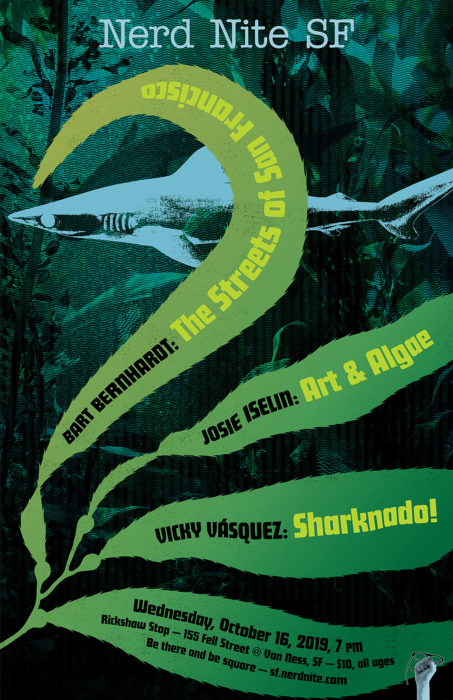 Take a deep breath and pinch your nose as we dive from the SS Rickshaw Stop and into a world of sinuous seaweed and shimmering sharks! We’ll transform algae into art and discover new species, and if that’s not enough to lure you out, we have DJ Alpha Bravo, a full bar, and Grilled Cheese Guy as bait. See you there, chums!
Take a deep breath and pinch your nose as we dive from the SS Rickshaw Stop and into a world of sinuous seaweed and shimmering sharks! We’ll transform algae into art and discover new species, and if that’s not enough to lure you out, we have DJ Alpha Bravo, a full bar, and Grilled Cheese Guy as bait. See you there, chums!
Wednesday, 10/16/2019
Doors at 7pm, show at 8
Rickshaw Stop, 155 Fell St @Van Ness
$10, all ages
Tickets here
“Sharknado, Shark Week, Ninjas, and Beer: Enough Said!” by Vicky Vásquez
Happy Sharktober, y’all! You’ve heard of the great white shark, of course, but have you heard of the honeycomb catshark, the lost shark, or the pyjama shark? Sharks that glow, take tiny bites of submarines, or fit in the palm of your hand? We’ll raise a pint to our finny friends as we discover strange new or lesser known species of sharks in a whirlwind adventure from collections archives to the inky ocean depths to science celebrity.
Vicky is a graduate student at Moss Landing Marine Laboratories (MLML), pursuing a Master’s in Marine Science with a focus on chondrichthyans and ecology through MLML’s Pacific Shark Research Center (PSRC). She tweets as @VickySharky
“Art & Algae” by Josie Iselin
In her newest book, “The Curious World of Seaweed”, author and artist Josie Iselin interweaves the science of seaweed with tales of pioneering women scientists and beautiful images of marine algae. Dive into the wondrous and surprising world of these foundational organisms.
Josie is a photographer, author and designer. She holds a BA from Harvard and an MFA from San Francisco State University. For many years she has used her flatbed scanner and computer for generating imagery. Iselin exhibits large-scale fine art prints at select galleries and museums, advocates for ocean health through education and speaks widely on the confluence of art and science.
“The Streets of San Francisco” by Bart Bernhardt
Curious about the names that grace our streets? They’re named after politicians and war heroes, sure, but also war losers, vigilantes, merchants, and scoundrels. Through them, they tell tales of colonization, accidental discoveries, wars, the Gold Rush, disastrous fires, and rampant crime. In this romp we’ll see how the history of San Francisco is written onto our very landscape.
Bart Bernhardt is the co-organizer of Nerd Nite SF, and sometimes when speaker booking goes awry he has to get on stage and give a talk himself.
With: Alpha Bravo, who’ll be spinning tunes specially selected to match the presenters’ themes. Follow the set list on Twitter @djalphabravo.
Food: The master of the grilled cheese sandwich returns!
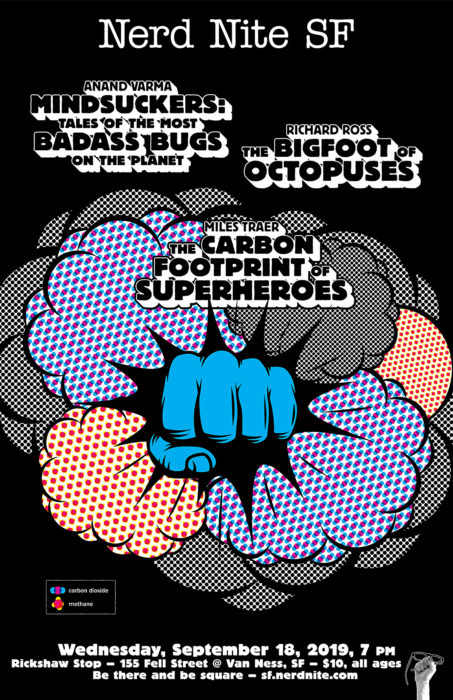 Wednesday, 9/18/2019
Wednesday, 9/18/2019
Doors at 7pm, show at 8
Rickshaw Stop, 155 Fell St @Van Ness
$10, all ages
Tickets here!
Grab a drink, feast with Miss Arepita, enjoy vinyl spun by DJAB, and see the wonders of the world. Be there and be square!
————————
“Mindsuckers: Tales of the Most Badass Bugs on the Planet” by Anand Varma
The stuff of nightmares: Parasites that hijack their host bodies. They control their minds. Force them to become their bodyguards, steer them into their burrows where the will be devoured alive, or compel them into the mouths of predators. How can they do this? Why? These parasites will change how you think about the evolution of life on Earth.
Anand started photographing natural history subjects while studying biology at the University of California, Berkeley. He uses photography to reveal the invisible details around us with the goal of sparking a sense of wonder about our world. He is a regular contributor to National Geographic Magazine. https://www.varmaphoto.com/
————————
“The Bigfoot of Octopuses” by Richard Ross
In the 1980s, accounts emerged of an octopus that behaved so unlike anything previously observed of octopuses—beak-to-beak mating, food sharing by mates, den sharing, strategic hunting, and the ability to stay alive through multiple spawns. The cephalopod research community deemed these early observations unbelievable, and attempts to publish a behavioral study by Panamanian marine biologist Arcadio Rodaniche were not successful, except for two tantalizing paragraphs that appeared in a notes section of a journal. For decades, these two paragraphs fascinated octopus enthusiasts but were largely still thought to be fantasy.
In 2012, Richard Ross of the California Academy of Sciences and Roy Caldwell of the University of California, Berkeley, were able to obtain live specimens and verify those early observations, and then publish their findings with Rodaniche as co-author. This talk will cover the unique behaviors of the larger Pacific striped octopus and the story of the rediscovery of this amazing animal—plus how it felt to finally get the bigfoot of octopus in the lab for study!
————————
“The Carbon Footprint of Superheroes” by Miles Traer
Our noble heroes are always ready to take action to save the world. But holy polluters, Batman! Those superpowers and super-gadgets can have super-carbon footprints! Geologist Miles Traer does the math on just how much CO2 our favorite so-called heroes produce. Avengers, disassemble?
Miles is a geologist and educator at Stanford University and creator of the award-winning Generation Anthropocene (https://www.genanthro.com/) podcast. He studies landscape evolution on Earth, Mars, and Saturn’s largest moon, Titan. Explore Miles’s research and pop-sci articles at www.milestraer.com.
————————
With: Alpha Bravo, who’ll be spinning tunes specially selected to match our presenters’ themes. Follow the set list on Twitter @djalphabravo
Food: Amazing arepas from Miss Arepita!
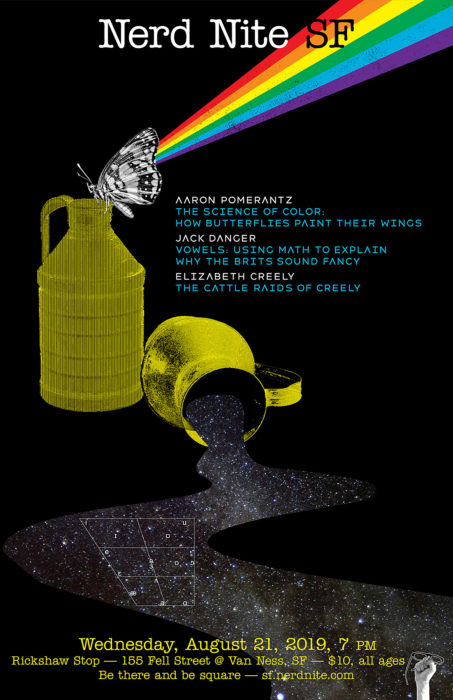 Wednesday, 8/21/2019
Wednesday, 8/21/2019
Doors at 7pm, show at 8
Rickshaw Stop, 155 Fell St @Van Ness
$10, all ages
Tickets here
Flutter on down to the Rickshaw Stop for lots of “oooohs” and “aaaaahs”, as we’ve rustled up some talks on coloration, vowels, and cattle raids! We promise you’ll never look at butterflies, lips, and milk the same way again. So come learn with us, drink up, binge on bao, and listen to vinyl spun by DJAB. Be there and be square!
————————
“The Science of Color: How Butterflies Paint their Wings” by Aaron Pomerantz
How is butterfly color created? In this lecture, Aaron Pomerantz takes us on a journey through the Amazon rainforest, where interesting observations about butterfly color and patterns lead him to use imaging and genetics to decode butterfly color.
Aaron is currently in a Ph.D. program in the Integrative Biology department in Dr. Nipam Patel’s lab at UC Berkeley, and is interested in how butterflies are able to produce such an incredible array of colors through the use of pigments and structural coloration.
————————
“Vowels: Using Math to Explain Why the Brits Sound Fancy” by Jack Danger
Were you taught the vowels “A”, “E”, “I”, “O”, and “U” ? Yeah, that’s not English, that’s Latin. In English we have twelve vowels. TWELVE. But we don’t have letters for them so we don’t talk about them. In this talk we’ll dive down our own throats and find the mechanisms that generate sound. Then we’ll plot that sound on a cartesian axis and visualize it. By the end of this talk you’ll speak in a sexy Australian accent, you’ll know how to pronounce ‘about’ like a Canadian (it’s not ‘aboot’), and you’ll realize that your parents may have raised you with one of the hardest languages on Earth.
Jack has a degree in Linguistics and at age 18 legally changed his middle name to “Danger” on a dare.
————————
“The Cattle Raids of Creely” by Elizabeth Creely
We don’t think of SF as a cow-town, but in the late 1800s they were certainly a common sight, and fresh milk was a dietary staple. It was also regularly adulterated with chemicals, contaminated water, and other foulness. Armed with six-shooters and lactometers, Edward Creely, SF’s official veterinary surgeon, and James P. Dockery, SF’s first Milk Inspector, waged a war on toxic milk, raiding pastures and dumping thousands of gallons onto the streets. Learn about these daring dairy deeds and the rise of modern public health policy in SF.
Elizabeth is a fourth-generation Irish Californian, Mission-based writer, public historian, and speaker who loves talking about dairies and the Irish. She’s the grandniece of Edward Creely.
————————
With: Alpha Bravo, who’ll be spinning tunes specially selected to match our presenters’ themes. Follow the set list on Twitter @djalphabravo
Food: Delicious bao from Cross Hatch Eatery.
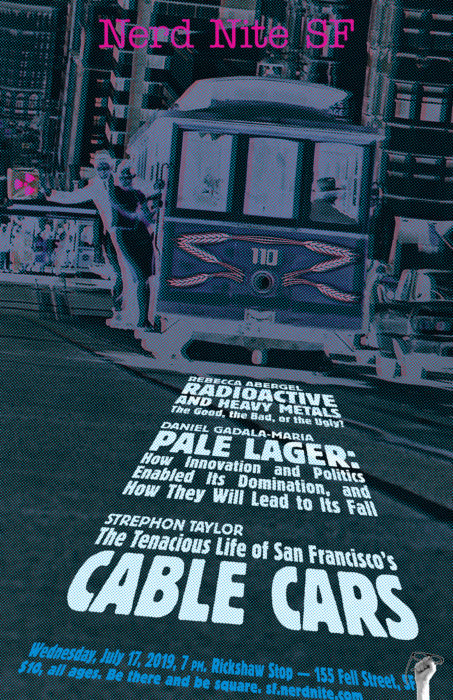 Drinking unusual beer, riding in cable cars and ridding oneself of dangerous levels of radioactive elements–three things that are absolutely wonderful. (Well, if you hate the taste of beer and think cable cars are overrated, at least we can agree on the third one!) So, pause your binge-watching of Chernobyl and come learn with us, drink up, get some reading recs from the SFPL, snarf gooey grilled cheese from the GCG, and listen to vinyl tunes from DJAB. Be there and be square!
Drinking unusual beer, riding in cable cars and ridding oneself of dangerous levels of radioactive elements–three things that are absolutely wonderful. (Well, if you hate the taste of beer and think cable cars are overrated, at least we can agree on the third one!) So, pause your binge-watching of Chernobyl and come learn with us, drink up, get some reading recs from the SFPL, snarf gooey grilled cheese from the GCG, and listen to vinyl tunes from DJAB. Be there and be square!
Wednesday, 7/17/2019
Doors at 7pm, show at 8
Rickshaw Stop, 155 Fell St @Van Ness
$10, all ages
Tickets here
————————
“Radioactive and Heavy Metals – The Good, the Bad, or the Ugly?” by Rebecca Abergel
Exposure to heavily radioactive elements after a nuclear accident is a terrifying thought. But radioactive elements – including some that were created and added to the periodic table by scientists here in the Bay Area – can be used in beneficial medical treatments that work like “nuclear bullets” to target diseased tissue and cancer cells. We’ve also developed chemical tools to remove unwanted radioactive contaminants from our bodies and our environment.
Learn about these from Rebecca, an Assistant Professor of Nuclear Engineering at UC Berkeley and Heavy Element Chemistry Group Leader at the Lawrence Berkeley National Laboratory. Her research focuses on investigating the fundamental coordination chemistry and biochemistry of heavy and f-elements.
(This talk brought to you by the 150th anniversary of the Periodic Table of Chemical Elements!)
————————
“Pale Lager: How Innovation and Politics Enabled Its Domination, and How They Will Lead to Its Fall” by Daniel Gadala-Maria
In the last century, American beer has been dominated by pale lager and often been likened to sex in a canoe…fucking close to water. Yet pale lagers also dominate globally: 92% of all beer fits into this narrow category. Beer has existed since prehistory, but pale lagers are younger than the U.S.A. So how the hell did we get here??? We’ll discuss the innovations and politics–some brilliant and some abhorrent–that have played a key role, starting with beer riots in the Czech Republic. But take heart! We’ll also cover how these same forces are now helping create a world that embraces and supports more diversity in beer!
Daniel Gadala-Maria was a biologist who, after a decade of study and beer-related side-gigs, turned his hobby into his profession; he’s now a brewer at Marin Brewing Co. and a beertender at The Monk’s Kettle.
————————
“The Tenacious Life of San Francisco’s Cable Cars” by Strephon Taylor
Before our modern transportation systems, U.S. cities were about as big as a person could easily walk. As technology advanced after the Civil War, the horse-drawn omnibus became the preferred method of mass transit and cities began growing. But after witnessing a horse-drawn streetcar accident, Andrew Smith Hallidie, a San Francisco resident, put his knowledge of Gold Rush ore mining using steel rope into action: On Clay Street in 1873, the first successful cable car gripped popular imagination and thus began our ride through history.
Since 2010, Strephon has been producing his own movies and music through November Fire Recordings. Most of the projects are celebrations of Halloween, sci-fi, and horror… and San Francisco: “Remembering Playland,” “Sutro’s: The Palace at Lands End,” “The Cliff House and Sutro Heights,” and now “San Francisco Cable Cars.” He has also shared wacky, spooky tales of San Francisco as the character Slob on “Creepy KOFY Movie Time.”
————————
With: Alpha Bravo, who’ll be spinning tunes specially selected to match our presenters’ themes. Follow the set list on Twitter @djalphabravo
Food: Grilled Cheese Guy!
Plus: The San Francisco Public Library will be on hand to dole out library cards, reading lists, and the hottest branch gossip.
 It’s December once more, which means it’s a great time to learn a whole bunch of strange, interesting, and funny things so you have a quiverful of “well actually’s” to spring on bewildered family members over holiday dinners. Come join us for boozy lectures, DJ Alpha Bravo, a full bar, and delicious eats. Be there and be square!
It’s December once more, which means it’s a great time to learn a whole bunch of strange, interesting, and funny things so you have a quiverful of “well actually’s” to spring on bewildered family members over holiday dinners. Come join us for boozy lectures, DJ Alpha Bravo, a full bar, and delicious eats. Be there and be square!



